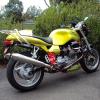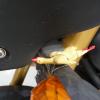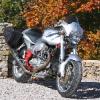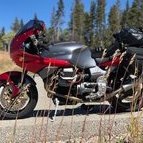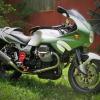Leaderboard
Popular Content
Showing content with the highest reputation on 01/25/2021 in all areas
-
I've experienced casting porosity quite a few times over the years with Italian motorcycles so why would the V11/V10 be any different. I thought I'd do a piece on dealing with it in the case of the Daytona engine, specifically the cylinder head. It's of course of no real import to anyone here V11 wise but may be of general interest. My original V11 engine had an issue with the oil drain back gallery in the l/h head apparently which the original owner had rectified with a sleeve. I've not had the opportunity to look at it but it has never leaked in the 10 years I've owned the bike, so I'll call it fixed. The issue with the Daytona engine arose a few months after I got it running with an annoying accumulation of a small amount of oil on one of the r/h cylinder fins. Originally I put it down to a leaky rocker cover gasket but a careful evaluation found it to be from one of the rocker cover attach screw blind holes. Four of the cover retaining screws are on the "wet" side of the cover o-ring and are blind holes to the external part of the head. Several of these holes had been over drilled at the factory by a very small amount and broken through to the head exterior. Oil was seeping down the thread holes and working its way to the outside and eventually to the edge of the cooling fins. Great, simple fix. Either seal the screws on fitment of the rocker cover, which is a bit of a pain or somehow seal the bottom of the holes. I took the latter path and screwed a 6X4 grub screw down to the bottom of the holes sealed with Loctite 242. This still left me with 12mm of thread engagement which was plenty. Here's a totally inadequate image of the screw hole with the grub screw in the bottom. Unfortunately the leaks persisted. I suspected it may have been from the spark plug drain gallery vertical wall. The vertical walls of this area of the head form an internal pair of drain "wells" with the head drain galleries at the bottom of these rectangular wells. Measuring a spare head I calculated the wall thickness here to be around 3mm which is pretty thin for a sand casting. I also recalled a brief thought flash through my mind when I was painting the heads that I'd better get paint up in there or I might end up with an oil seep issue. Funny the fleeting thoughts that come back to you in hindsight. I've long suspected that one of the primary reasons for the Italians painting engines going back 35 years of so was to preclude these porosity issues. Here you can see in this damaged spare head the drain wells and the spark plug drain gallery exit between the fins. One well has a red sealing coat over the area that forms the roof and vertical wall of half the plug drain gallery and the other roof section and vertical wall section is unsealed. I wanted to test the sealer in the oven to makes sure it would stand the local heat in the head. I painted on some dye check developer to these vertical walls inside the plug drain gallery and sure enough the tell-tale signs of porosity seeping. First image the r/h head and the second the l/h. The dark round patches in the white developer are the tells. So the challenge is how to fix this without pulling the heads if possible. Pulling the heads is a pain. Apart from the actual work involved you then need to go through the retorque process and reset the valve clearances etc. painful. Part of what I did in my professional aviation career was to come up with insitu technical solutions to to keep aircraft out of the hangar flying an earning a dollar so I put that hat on and had a muse. The typical way to address porosity issues is to clean the component, heat it up which will usually bring any trapped oil out of the casting and then drop the whole thing in a warm bath of loctite 290 wicking grade and let it soak for a few hours and wash it down and the porosity is sealed. Not possible here of course without pulling and disassembling the heads. There are commercial variations on this process that immerse the component in a vacuum chamber and then a pressure chamber of 290 or variations on that material but once again not insitu. What I eventually came up with was a vacuum system using a brake bleeding pump and home made rubber seal. I sealed off the spark plug end of the plug drain gallery with aluminium tape and connected my homemade seal to the vacuum pump at the outer end to create a 27 inch vacuum in the plug drain gallery. The outer rubber seal was made from an old piece of rubber thong sole. This would hold a vacuum quite well with a few pumps every 3 or 4 minutes. An image of the aluminium tape used to seal the plug drain gallery at the plug hole end I then devised a rubber plug to seal the drain hole in the bottom of the head drain wells. A little tricky as with the head rocker gear support installed the hole isn't visible without a mirror. Here's the plug. Here's the plug installed on the head on the engine with the drain well filled with 290. Some of the images are from "proof of concept" experiments with my spare damaged head on the bench. Painting on the internal sealer insitu was a fiddly job with the rocker arm supports in the way but with small brushes bent to various shapes quite doable. So the process now was to fill the plugged drain well and fill them with solvent and pull a vacuum in the plug drain gallery to draw the solvent through the porosity and clean out residual oil. Then dry out the drain well and repeat the process with the loctite to seal the porosity. I inserted a small piece of paper towel inside the plug drain cavity on both occasions with the solvent and the loctite to get an indication if my process was sound. If you look carefully you can see a light green tinge to the paper, so the solvent and loctite were migrating through the porosity. So repeat for the other head area and the jobs almost done. I wanted a little "belt and braces" assurance so in addition to the loctite sealing I also coated the well areas with Glyptal internal engine sealer as well. That's the reddish coating. So I can claim a complete success I'm happy to say. Nice and oil tight. Next time I'll listen to my small internal voice a bit more closely and do the due diligence on those areas I know intuitively could be an issue. Ciao4 points
-
Jaap ha ragione. Ho parlato con un rappresentante del comitato organizzativo e mi ha informato che a Mandello è praticamente impossibile trovare una sistemazione per dormire e dove alloggiare...è tutto prenotato da più di un anno. Anche per il noleggio delle moto stesso discorso. Comunque mi manderà alcuni link dove poter cercare un alloggio (sicuramente non a Mandello) ed altre informazioni utili che vi girerò appena possibile. Jaap is right. I spoke to a representative of the organizing committee and he informed me that in Mandello it is practically impossible to find accommodation to sleep and where to stay ... everything has been booked for more than a year. Even for the rental of motorcycles the same goes. However, he will send me some links where you can look for accommodation (certainly not in Mandello) and other useful information that I will send you as soon as possible.3 points
-
Well, he wasn't going very fast, but he *was* having a good time.. and that is what it is all about anyway.3 points
-
Nice video. A good thing to do once you have the plate installed is to drop the dipstick in the hole and mark it level with the bottom face of the Roper plate, remove and drill a 1.5mm hole in the dipstick as your new "full" mark. Ciao2 points
-
Well said .... good tech plus philosophy talk :-> I favor the idea of being able to not worry about the maps and gadgetry, but even as i try and slow down a bit and “smell the roses”, life is still too full of all the things that make my goofy world go round, to where losing a day or half day to a wrong turn, even if it involves some discovery, might be a hassle I’d rather avoid under the circumstances. Recognizing that later in life presumably things will change and more time will be available. For instance, I might have 2 days to get somewhere for a pop-up opportunity ... 3 would be best given the distance, whereas 1 day would mean grinding straight through, and of course I have the option to just park the bike and fly there. So if reasonably planned, i can make a 2 day window a good, if not ideal, chance to get out on the machine. I’ll take that 2 day run, but pretty much need to utilize reasonable nav tools to assure its not a “gilligans island 3 hour tour...” When i do have time to plan a trip, i mentioned my fondness of the nearly ubiquitous Google maps option. Mostly the maps can be downloaded for offline use (some areas don’t allow it, like japan, which seems odd to me), and route building is so easy, on the laptop, iPhone, or iPad. Then i email the routes to myself, so they are there in an email inbox folder, or I might save the hyperlinks for the route on a cloud folder, again so they are easily accessed at about any time, except when off-line. If i know I’ll be off-line a lot (Alaska, etc), I’ll make the extra effort to convert the tracks into .GPX tracks, so i can import them into whichever app I’m using that year, like MotionX (apple) or Locus Pro (android), etc. converting to GPX has been the worst part of google maps, as the option to do so keeps shifting, from hard, to easy, to nearly impossible, and so on, based on that years developments. Key there though is that it’s usually less about the specific route and more about just having the downloaded map and blue-dot location. Pretty much just the higher-resolution and “self finding” version of a paper road map. Still provides that mental element that lets you get to know the area you’re traveling in, but with less hassle. each winter i still mess with some of the latest options, keeping an old android phone operational (no sim chip) for LocusPro, Osmand, and of course google maps. And i keep my daily iphone up to speed with MotionX and some others (more recently have gone back to Avenza and Pocket Earth again), just to see what cool new developments may look desirable (vs just being more layers of hassle). And then i keep an old iPad mini (model 2?) just barely alive so it can display the map i want while actually traveling. Can airdrop a route from the iphone, or use wifi to upload a map or route, and it provides for good visibility and "pinch" zoom, in a format thats big enough for my eyeballs. had a monstrous GPS that came already mounted on my used Duc Multi enduro a few years ago. i think it's meant for a boat... seriously. was sort of cool, but again, the interface (software) is so clunky. You've got a weather-proof moving map in front of you, but god knows what the hell you're looking at, as the database's that were supported were not at all friendly for eyes that want to glance down for guidance but not stare at a complicated map for long periods. that issue i find to be fairly common with map apps, where they may have the good data, but displayed in a way that you have to stop and stare at it too much to figure out what you're looking at.... too much staring, not enough riding.2 points
-
Just think me old and in my ways, and not incredulous to available technology or ones use of it. Keep in mind, I don't lead rider groups but DO yield to the ones who do, and their judgement and generous sense of responsibility. While you may have intended this as a tech device query, it jumps out at me as a philosophical question. Sorry I can't help with devices, but on a motorcycle I don't use anything electronic. I look at a map and head the direction Of intent. I might get lost? ?... Don't threaten me with a good time. I am precisely where I intend to be. Wandering. I might find a treasure of a town, my next good meal or a new friend, or the answer to what I've always wondered about. To each his own but we all jump on the bike for different reasons. For me it's discovery. To be honest, the only occasions I have been "misdirected" I was following group tour leaders using GPS devises. Always simple software map mistakes, always easy to correct, and always comical. We always had a stop and a laugh. But still... the fault of devise "confusion", be it old software or changing sat reference. An aside... Once my young nephew, on a trip with friends, found himself in a very small Ohio town gas station with a worn through rear tire. His buddies had to leave him there to deal with it. He phoned me to please come get him with a trailer. I said no. A 5 to 6 hour round trip for me. Not for a tire. Take a deep breath and look around you. This is your adventure, live it. I googled a nearby B&B for him and he walked to it, had a good dinner, met some kind people, spent the night and was referred to a local lawnmower/powersport repair shop that had a tire and installed it the next day. Most of you here wouldn't need this advise, but he did. And he was better off for it. My point is, think back to what you did before GPS. Use what you did then. Your wits, a paper map, the sun, and the offerings of strangers. It was easy. Ok... look at the blue dot when you need to. The greatest pleasures are the simplest.2 points
-
Ciao, vi inoltro le informazioni che mi ha fornito il mio amico Sergio, presidente del Guzzi Motoclub Carlo Guzzi e membro del Comitato Motoraduno Internazionale: "" Noi non possiamo fare da tramite per le camere. Abbiamo sempre disponibili posti tenda in zona raduno. In accordo con amministrazione diamo un paio di link che possono aiutare nelle prenotazioni. Chi vuole può comunque scrivere al motoclub su fb Guzzi motoclubcarloguzzi e daremo risposta appena possibile."" Hello, I forward you the information that my friend Sergio, president of the Guzzi Motoclub Carlo Guzzi and member of the International Motorcycle Rally Committee gave me: "" We cannot act as an intermediary for the rooms. We always have tent places available in the meeting area. In agreement with the administration we give a couple of links that can help with reservations. Anyone who wants can still write to the motoclub on fb Guzzi motoclubcarloguzzi and we will reply as soon as possible. "" https://www.visitmandello.it/it/ospitalita https://www.lakecomo.is/be-our-guest-accommodation/ Spero di esser stato utile I hope I have been helpful1 point
-
Sorry, with the plate installed and before you fit the sump insert the dipstick and mark it level with the plate lower surface then remove the stick and drill a hole. This way you know exactly when the oil level is at the bottom of the plate which is full. Ciao1 point
-
1 point
-
I am sure you can get the first three w/o much trouble ...............1 point
-
Yes Pete "super wick-in" is the 290 green stuff. Low viscosity. And yes Araldite is another fix. Many round case bevel drive Ducati's back in the early 70's had Araldite in the cases from the factory. When I put Desmoquatro engines together with new cases I used to go to the importers and they would bring out their whole stock of crankcases and I'd go through them and chose the one with the least porosity. Not, no porosity but the least! Ciao1 point
-
I've had a few porous heads on 8V's, the castings are quite thin and the cooling drilling's complicate things. I've had quite good success using Loctite 'Super Wick-in', can't remember the number. Sometimes a smear of epoxy over the top works wonders.1 point
-
1 point
-
IF your not in a rush too sell, I’ll offer 4500 and have the bike shipped On or before may 1 240 343 0488 Bill1 point
-
Seems his daughter Vittorio has the B&B while Ago has opened his Trophy Room and is still passionate about his tifoso ("fans"). What a fine gentleman. Such a credit to the sport.1 point
-
While you are there, stop by Bergamo and tell Giacomo Agostini "ciao" from all of us! https://www.villavittoriabergamo.it/en/who-we-are/ https://www.motociclismo.it/giacomo-agostini-apre-museo-bergamo-739311 point

